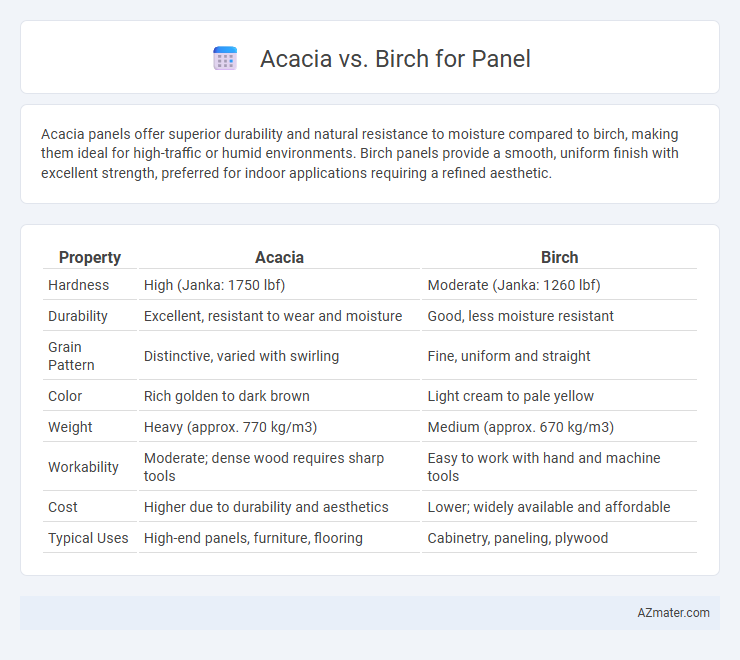Acacia panels offer superior durability and natural resistance to moisture compared to birch, making them ideal for high-traffic or humid environments. Birch panels provide a smooth, uniform finish with excellent strength, preferred for indoor applications requiring a refined aesthetic.
Table of Comparison
| Property | Acacia | Birch |
|---|---|---|
| Hardness | High (Janka: 1750 lbf) | Moderate (Janka: 1260 lbf) |
| Durability | Excellent, resistant to wear and moisture | Good, less moisture resistant |
| Grain Pattern | Distinctive, varied with swirling | Fine, uniform and straight |
| Color | Rich golden to dark brown | Light cream to pale yellow |
| Weight | Heavy (approx. 770 kg/m3) | Medium (approx. 670 kg/m3) |
| Workability | Moderate; dense wood requires sharp tools | Easy to work with hand and machine tools |
| Cost | Higher due to durability and aesthetics | Lower; widely available and affordable |
| Typical Uses | High-end panels, furniture, flooring | Cabinetry, paneling, plywood |
Introduction to Acacia and Birch Wood
Acacia wood is known for its durability, rich golden-brown hues, and natural resistance to moisture and insects, making it ideal for furniture panels with a rustic yet refined appearance. Birch wood features a pale, creamy color with a smooth, even grain that enhances the modern aesthetic of interior panels while offering moderate hardness and good workability. Both Acacia and Birch provide versatile options for paneling, with Acacia favored for its robustness and distinctive grain, while Birch is prized for its uniform texture and lighter tone.
Botanical Background of Acacia and Birch
Acacia belongs to the Fabaceae family, known for its fast-growing hardwood species native to Australia and Africa, characterized by dense, durable timber with distinctive grain patterns. Birch, part of the Betulaceae family, is commonly found in temperate regions of the Northern Hemisphere, featuring fine-grained, pale wood prized for its strength and smooth finish. Both trees provide quality wood for panel applications, with Acacia offering rich color tones and durability, while Birch delivers a lighter, uniform texture ideal for precise woodworking.
Physical Properties: Acacia vs Birch
Acacia wood features high density and natural oils, resulting in superior water resistance and durability compared to Birch, which is lighter and more prone to dents and moisture damage. Birch has a fine, even grain pattern offering a smooth finish ideal for painting, while Acacia's coarser grain provides a distinctive, textured appearance with excellent strength. The hardness of Acacia ranks higher on the Janka scale, making it more suitable for heavy-use panels in demanding environments, whereas Birch is favored for indoor applications requiring a softer touch.
Aesthetic Differences in Paneling
Acacia panels showcase rich, warm tones with distinctive grain patterns that create a natural, rustic appeal, while birch panels offer a lighter, more uniform appearance with subtle grain lines that complement modern and minimalist designs. The pronounced swirling and knot features in acacia provide a textured, dynamic surface, contrasting with birch's smoother, consistent finish which lends itself to sleek, clean aesthetics. Choosing between acacia and birch for paneling depends on whether the design prioritizes bold, organic character or bright, understated elegance.
Durability and Hardness Comparison
Acacia wood boasts exceptional durability and hardness, ranking around 2,200 on the Janka hardness scale, making it highly resistant to dents and wear for panel applications. Birch, with a Janka hardness of approximately 1,260, offers moderate hardness but is less durable under heavy impact or moisture exposure compared to Acacia. Choosing Acacia panels provides superior longevity and robustness for high-traffic or moisture-prone environments, whereas Birch panels suit lighter, indoor settings with less demanding durability requirements.
Workability and Ease of Installation
Acacia wood offers excellent workability due to its moderate density and natural resistance to splitting, making it easier to cut, shape, and fasten for panel installation. Birch, known for its fine grain and smooth texture, provides superior ease of installation with consistent strength and minimal warping, ensuring panels fit tightly and securely. Both hardwoods support efficient handling, but Acacia's slight hardness may require sharper tools, whereas Birch's uniformity reduces installation time.
Environmental Impact and Sustainability
Acacia wood is known for its rapid growth and high carbon sequestration rate, making it a more sustainable choice compared to birch, which grows slower and requires more energy for harvesting. Acacia panels have a lower environmental impact due to their durability and resistance to pests, reducing the need for chemical treatments. Birch, while aesthetically appealing, often demands intensive forestry practices that can negatively affect biodiversity and soil health.
Cost Analysis: Acacia vs Birch Panels
Acacia panels typically cost more than birch panels due to their durability and exotic appeal, with prices ranging from $6 to $12 per square foot compared to birch's $4 to $8 per square foot. The higher cost of acacia is offset by its resistance to scratches and moisture, making it a long-term investment for high-traffic areas. Birch panels offer a budget-friendly option with consistent grain patterns ideal for painted finishes, though they may require more maintenance over time.
Best Applications in Interior Design
Acacia wood's rich grain and durability make it ideal for statement walls and high-traffic paneling in interior design, offering both aesthetic appeal and long-lasting performance. Birch panels, known for their light color and smooth texture, excel in modern and minimalist spaces, providing a clean and bright backdrop that enhances natural light. Both woods suit cabinetry and furniture, with Acacia lending warmth to rustic or eclectic interiors, while Birch supports contemporary and Scandinavian styles.
Final Verdict: Choosing the Right Wood for Panels
Acacia offers a rich, warm tone and superior durability, making it an excellent choice for high-traffic areas and stylish panels. Birch provides a lighter, more uniform grain and is generally more cost-effective, suitable for modern, minimalist designs. The final verdict depends on balancing aesthetic preference, budget, and durability needs, with Acacia favored for longevity and Birch for affordability and clean appearance.

Infographic: Acacia vs Birch for Panel
 azmater.com
azmater.com